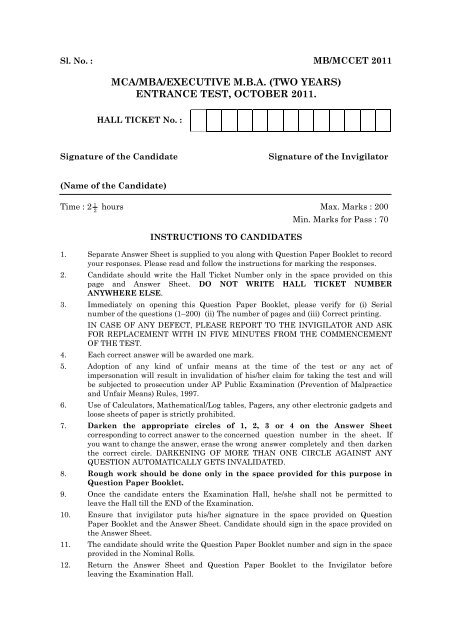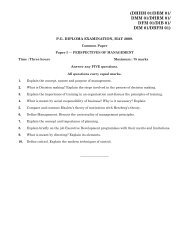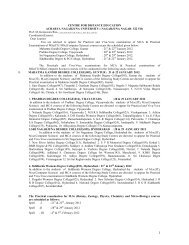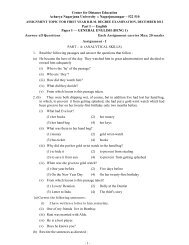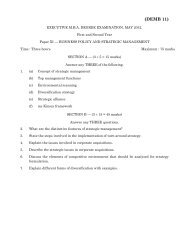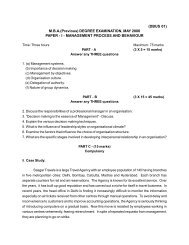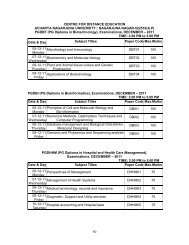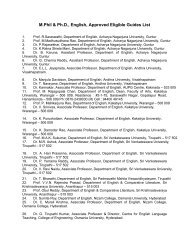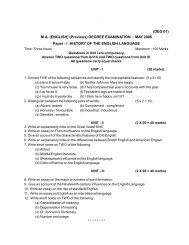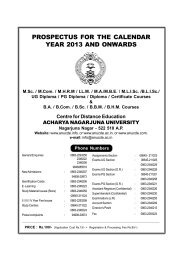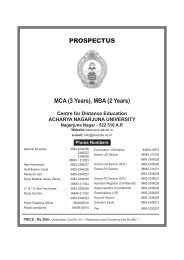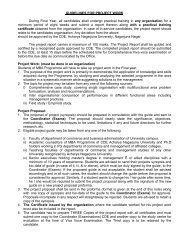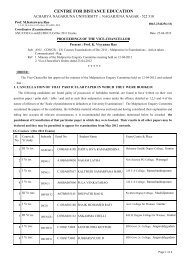MBA/MCA Entrance Test - October - 2011 - ANUCDE
MBA/MCA Entrance Test - October - 2011 - ANUCDE
MBA/MCA Entrance Test - October - 2011 - ANUCDE
You also want an ePaper? Increase the reach of your titles
YUMPU automatically turns print PDFs into web optimized ePapers that Google loves.
Sl. No. : MB/MCCET <strong>2011</strong><br />
<strong>MCA</strong>/<strong>MBA</strong>/EXECUTIVE M.B.A. (TWO YEARS)<br />
ENTRANCE TEST, OCTOBER <strong>2011</strong>.<br />
HALL TICKET No. :<br />
Signature of the Candidate<br />
Signature of the Invigilator<br />
(Name of the Candidate)<br />
Time : 2 2<br />
1<br />
hours Max. Marks : 200<br />
INSTRUCTIONS TO CANDIDATES<br />
Min. Marks for Pass : 70<br />
1. Separate Answer Sheet is supplied to you along with Question Paper Booklet to record<br />
your responses. Please read and follow the instructions for marking the responses.<br />
2. Candidate should write the Hall Ticket Number only in the space provided on this<br />
page and Answer Sheet. DO NOT WRITE HALL TICKET NUMBER<br />
ANYWHERE ELSE.<br />
3. Immediately on opening this Question Paper Booklet, please verify for (i) Serial<br />
number of the questions (1–200) (ii) The number of pages and (iii) Correct printing.<br />
IN CASE OF ANY DEFECT, PLEASE REPORT TO THE INVIGILATOR AND ASK<br />
FOR REPLACEMENT WITH IN FIVE MINUTES FROM THE COMMENCEMENT<br />
OF THE TEST.<br />
4. Each correct answer will be awarded one mark.<br />
5. Adoption of any kind of unfair means at the time of the test or any act of<br />
impersonation will result in invalidation of his/her claim for taking the test and will<br />
be subjected to prosecution under AP Public Examination (Prevention of Malpractice<br />
and Unfair Means) Rules, 1997.<br />
6. Use of Calculators, Mathematical/Log tables, Pagers, any other electronic gadgets and<br />
loose sheets of paper is strictly prohibited.<br />
7. Darken the appropriate circles of 1, 2, 3 or 4 on the Answer Sheet<br />
corresponding to correct answer to the concerned question number in the sheet. If<br />
you want to change the answer, erase the wrong answer completely and then darken<br />
the correct circle. DARKENING OF MORE THAN ONE CIRCLE AGAINST ANY<br />
QUESTION AUTOMATICALLY GETS INVALIDATED.<br />
8. Rough work should be done only in the space provided for this purpose in<br />
Question Paper Booklet.<br />
9. Once the candidate enters the Examination Hall, he/she shall not be permitted to<br />
leave the Hall till the END of the Examination.<br />
10. Ensure that invigilator puts his/her signature in the space provided on Question<br />
Paper Booklet and the Answer Sheet. Candidate should sign in the space provided on<br />
the Answer Sheet.<br />
11. The candidate should write the Question Paper Booklet number and sign in the space<br />
provided in the Nominal Rolls.<br />
12. Return the Answer Sheet and Question Paper Booklet to the Invigilator before<br />
leaving the Examination Hall.
MB/MCCET <strong>2011</strong><br />
COMMON ENTRANCE TEST FOR <strong>MCA</strong>/<strong>MBA</strong>/EXECUTIVE <strong>MBA</strong><br />
PROGRAMME : 2010–11<br />
Time : 2 2<br />
1<br />
hours<br />
Maximum : 200 marks<br />
SECTION A<br />
ANALYTICAL ABILITY<br />
75 Marks<br />
Directions (Q. No. 1-20): A question is followed by data in the form of<br />
two statements labeled as I and II. You must decide whether the data<br />
given in the statements are sufficient to answer the questions. Using<br />
the data make the appropriate choice from (1) to (4) as per the<br />
following guidelines:<br />
(a) Mark choice (1) : if statement I alone is sufficient to answer the<br />
question;<br />
(b) Mark choice (2) : if statement II alone is sufficient to answer the<br />
question;<br />
(c) Mark choice (3) : if both statements I and II are sufficient to answer<br />
the question, but neither statement alone is not<br />
sufficient;<br />
(d) Mark choice (4) : if both the statements I and II together are not<br />
sufficient to answer the questions and additional data<br />
is required.<br />
1. What is the average mark of 10 students<br />
(I) The average mark of 9 of them is 60.<br />
(II) The marks obtained by one of them is 52.<br />
⎡5<br />
6⎤<br />
2. If A is the matrix ⎢ ⎥ , then what is the value of x<br />
⎣x<br />
4 ⎦<br />
(I) A is not a symmetric matrix.<br />
(II)<br />
A is a singular matrix.<br />
3. What is the volume of the cone<br />
(I)<br />
(II)<br />
The height of the cone is 10 cm.<br />
The area of its base is 126 sq.cm.<br />
4. What are the values of the real numbers a and b<br />
(I) 2 is a root of x a − b = 0 .<br />
(II) 2 is a root of a − a = 0 .<br />
4<br />
x<br />
3
5. What are the values of the real numbers a and b<br />
(I) a : b = 7 : 3, b > 0 .<br />
(II) 2a : b = 6 : 11, a > 0 .<br />
6. Is the positive integer a divisible by 42<br />
7. Is<br />
(I) a is not divisible by 7.<br />
(II) a is divisible by 21.<br />
(log<br />
2<br />
2<br />
10 ) (log10<br />
y)<br />
(I) x = y = 10<br />
x = <br />
(II)<br />
2<br />
x > y<br />
2<br />
8. What is the area of the triangle formed by joining the points A, B and C<br />
(I) A = (2, 5)<br />
, B = (3, 2)<br />
.<br />
(II) A, B and C lie on a straight line.<br />
9. If x, y and n are positive integers, is<br />
(I) x = 21<br />
(II) y = 1001<br />
n<br />
n<br />
x + y divisible by 2<br />
10. Is ab = cd <br />
(I) a% of c is equal to b% of d.<br />
(II) b% of c is equal to d% of a.<br />
11. How many degrees is the angle x<br />
z<br />
(I) y = 120°<br />
(II) z = 87°<br />
y<br />
x<br />
12. If b, c are positive integers, is b + c , a prime number<br />
(I)<br />
(II)<br />
b and c are odd<br />
c = 5b<br />
MB/MCCET <strong>2011</strong> 4
13. Each student in a hostel speak Telugu or Kannada or both. What is the<br />
number of students who can speak Telugu only<br />
(I)<br />
The total number of students in the hostel is 500 and the number of<br />
students who can speak both Telugu and Kannada is 156.<br />
(II) The number of students who can speak Kannada only is 124.<br />
14. Is x the largest among the positive real numbers x, y and z<br />
(I) x − y > |z|<br />
(II) x + z > 2|<br />
y|<br />
15. How many of A, B, C and D got selected into hockey team<br />
(I) The statement ‘Atleast one of A and B got selected into the team’ is true.<br />
(II) The statement ‘C and D are selected into the team’ is False.<br />
16. Is the triangle ABC right angled<br />
(I)<br />
A = 2<br />
B<br />
(II)<br />
2<br />
B = 3<br />
C<br />
17. Four circles of equal radius are inscribed in a square touching each other.<br />
What is the area covered by the four circles<br />
(I)<br />
(II)<br />
The perimeter of the square is 32 cm.<br />
The ratio of the sum of the areas of the four circles to that of the square is<br />
π : 4 .<br />
2 ><br />
18. If x, y, z are distinct integers, is ( x − y)<br />
0 <br />
(I)<br />
(II)<br />
z = 2x<br />
y > x<br />
19. What is the cost of painting a room which is of the form of a cube<br />
(I) The base area of the room is 144 sq. ft.<br />
(II) The room has one door of size 6 ′ × 4′<br />
and has no windows.<br />
20. If a, b, c are positive integers, is the product abc even<br />
(I)<br />
(II)<br />
a + b + c is odd.<br />
a + c is odd.<br />
5<br />
MB/MCCET <strong>2011</strong>
PROBLEM SOLVING<br />
Directions (Q.21 to Q.35) : In each of the questions numbered 21 to 35 a<br />
sequence of numbers or letters that follow a difine pattern is given.<br />
Each question has a blank space. This has to be filled by the correct<br />
answer from the four given options to complete the sequence without<br />
breaking the pattern.<br />
21. 6, 27, 128, —————, 3130<br />
(1) 209 (2) 369 (3) 629 (4) 1031<br />
22. 7, 19, 37, 61, —————, 127<br />
(1) 91 (2) 101 (3) 111 (4) 121<br />
23. 99, 9999, 999999, —————, 99999999999<br />
(1) 9999999 (2) 99999999<br />
(3) 999999999 (4) 99999999999<br />
3 15 63<br />
24. , , ,<br />
4 16 64<br />
1023<br />
————— 1024<br />
(1)<br />
127<br />
128<br />
(2)<br />
255<br />
256<br />
(3)<br />
511<br />
512<br />
(4)<br />
711<br />
712<br />
25. 3, –1, 5, –7, —————, –31<br />
(1) 9 (2) 11 (3) 15 (4) 17<br />
26. DFI, EGJ, FHK, —————, HJM.<br />
(1) GIM (2) GIL (3) HJN (4) HIM<br />
27. 4 + 13,9 + 10,<br />
—————, 25 + 4<br />
(1) 14 + 7 (2) 15 + 7 (3) 16 + 7 (4) 19 + 7<br />
28. A9Z, B7Y, CSX, —————, EIV.<br />
(1) D2W (2) D4W (3) D3U (4) D3W<br />
29. 8 : 81 :: 6 : —————<br />
(1) 25 (2) 36 (3) 49 (4) 64<br />
MB/MCCET <strong>2011</strong> 6
30. 99 : 120 :: ————— : 63<br />
(1) 48 (2) 42 (3) 36 (4) 24<br />
31. 22 : 2222 :: 222 : —————<br />
(1) 22222 (2) 2222 (3) 222222 (4) 2222222<br />
32. LFHW, KEGV, JDFU, —————<br />
(1) ITCE (2) ICET (3) IECT (4) ETCI<br />
33. 11, 101, 1001, —————, 100001, 1000001<br />
(1) 1001 (2) 10001 (3) 10000001 (4) 100000001<br />
34. 2, 3, 5, 7, 11, 13, —————, 19, 23<br />
(1) 14 (2) 15 (3) 16 (4) 17<br />
35. T, W, Z, C, —————<br />
(1) D (2) E (3) F (4) H<br />
Directions (Q.36 to 45) : Find the ODD MAN out.<br />
36. (1) 65 (2) 126 (3) 217 (4) 343<br />
37. (1)<br />
15<br />
19<br />
(2)<br />
11<br />
13<br />
(3)<br />
3<br />
7<br />
(4)<br />
2<br />
5<br />
38. (1) 345 (2) 143 (3) 567 (4) 789<br />
39. (1) 169 (2) 961 (3) 131 (4) 625<br />
40. (1) 697 (2) 957 (3) 894 (4) 876<br />
41. (1) 96 (2) 64 (3) 48 (4) 78<br />
42. (1) DELM (2) BDIJ (3) GHRS (4) PQAB<br />
43. (1) BFH (2) MQS (3) GJL (4) NRT<br />
44. (1) Planet (2) Satellite (3) Sky (4) Star<br />
45. (1) Bat (2) Eat (3) Fat (4) Pot<br />
7<br />
MB/MCCET <strong>2011</strong>
Directions (Q.46 - 50) : These questions are based on diagram:<br />
6<br />
3<br />
8<br />
10<br />
1<br />
7 4<br />
9<br />
5<br />
3<br />
Square represents the players who play “Playing Cards”. Rectangle represents<br />
the players who play “Chess”. Circle represents the players who play “Table<br />
Tennis” and Triangle represents the players who plays “Squash”.<br />
46. The players who plays chess is<br />
(1) 8+1+7+5+3+4 (2) 8+1+9+5+3+4<br />
(3) 8+1+9+2+6+4 (4) 8+1+3+4+5+2<br />
47. The players who play both chess and table tennis but not any other game is<br />
(1) 4 (2) 5 (3) 8 (4) 10<br />
48. The players who play at-most two game is<br />
(1) 1+2+3+4+5+6+9+7 (2) 2+3+4+5+6+7+8+9<br />
(3) 2+3+4+5+7+10+8+9 (4) 2+3+6+7+5+8+10+4<br />
49. The players who play at least two games is<br />
(1) 1+2+3+4+5+8+10+9 (2) 4+5+8+10+9+1<br />
(3) 1+3+4+5+9+8+10 (4) 4+5+7+10+9+1<br />
50. The players who play exactly one game is<br />
(1) 2+3+4+8 (2) 2+3+5+9<br />
(3) 2+3+6+7 (4) 2+3+10+7<br />
MB/MCCET <strong>2011</strong> 8
Directions (Q.No. 51 to 55):<br />
Study the following pie chart and answer the questions 51 to 55.<br />
Expenditure pattern of Mr : Jaideep<br />
Monthly salary of Mr. Jaideep is Rs.24,000 in 2006.<br />
Savings<br />
10%<br />
Others<br />
Food<br />
10%<br />
Income<br />
Tax<br />
30%<br />
Rent<br />
33 1/4<br />
Transport<br />
12%<br />
51. What is the ratio of the amount meant for others to that of food<br />
(1) 7:15 (2) 17:30 (3) 15:7 (4) 3:4<br />
52. What is the amount of rent paid by Mr. Jaideep per month<br />
(1) Rs. 7500 (2) Rs. 8000 (3) Rs. 8500 (4) Rs. 9000<br />
53. What is the angle made by the sector representing the transport expenditure<br />
(1) 41.8° (2) 42.2° (3) 43.2° (4) 38.2°<br />
54. If Mr. Jaideep’s salary increases by 10% and income tax also increases by 10%<br />
over its existing rate then what will be his new savings, given that all other<br />
components have the same percentage as in 2006<br />
(1) Rs. 1940 (2) Rs. 2080 (3) Rs. 2240 (4) Rs. 1848<br />
55. Mr. Jaideep could not go to work for six days in June 2006 due to ill health and<br />
it was a loss of pay during that period. At the end of that month, what was his<br />
net salary after payment of income tax<br />
(1) Rs. 14800 (2) Rs. 13440 (3) Rs. 12880 (4) Rs. 13220<br />
9<br />
MB/MCCET <strong>2011</strong>
Directions (Q.56 to 65) :<br />
CODING AND DECODING<br />
Note: If “BDCFMA” and “RSOQMR” coded as follows “STNOQP” and<br />
“DZEEFC” then what is the code follows:<br />
56. IHBNJD =<br />
(1) AWQUVO (2) AWQVUO (3) WAQUVO (4) WAUQUO<br />
57. ZYTFKA =<br />
(1) MLGSTM (2) MLGXSN (3) MLGSXN (4) NLGSXM<br />
58. RLODQG =<br />
(1) QDTEYB (2) QDYETB (3) YETBCD (4) YETCBD<br />
59. RAINBW =<br />
(1) AOJNEW (2) AJONEV (3) JOAINV (4) AOJENV<br />
60. SMTWTS =<br />
(1) JGFFZG (2) JGFZFG (3) JFGZFG (4) JZFGFG<br />
61. HORMON =<br />
(1) ZABUBE (2) ZBAUBE (3) ZBAOEB (4) ZUBABE<br />
62. LOVING =<br />
(1) VYTABI (2) VTABIY (3) VATYBI (4) VTBAYI<br />
63. SITUAS =<br />
(1) HNFFVG (2) HFFNVG (3) HNFVFG (4) HFNFVG<br />
64. LDROLW =<br />
(1) BJYYQE (2) EJYYQB (3) BYJYQB (4) BYJQYE<br />
65. GOVMNT =<br />
(1) ZAGTBI (2) ZGATBI (3) ZTEABI (4) ZBTGAI<br />
MB/MCCET <strong>2011</strong> 10
DATE, TIME AND ARRANGEMENT<br />
66. In a leap year January 26 is Friday, what is the day of August 15 in the same<br />
year<br />
(1) Sunday (2) Friday (3) Thursday (4) Tuesday<br />
67. Sun as the reflection of a wall clock in a mirror. Its image show the times as<br />
2 hours 30 minutes. What is the actual time shows in the clock<br />
(1) 9 hrs 30 min (2) 10 hrs 30 min<br />
(3) 11 hrs 30 min (4) 7 hrs 30 min<br />
68. How many times the angle between hours hand and minute hand is 180° in<br />
12 hours<br />
(1) 10 (2) 11 (3) 12 (4) 13<br />
69. Mr. A has a son B and daughter C, D is the wife of B and E is daughter of C.<br />
How is D related to E<br />
(1) Sister (2) Uncle<br />
(3) Aunt (4) Grand Mother<br />
Directions (70-72):<br />
There are 5 students A, B, C, D, E sitting on a Bench. A is at extreme left.<br />
B is second from extreme right. E and B are sitting together, E and C are<br />
sitting together, B and D are sitting together.<br />
70. Who is at the extreme right<br />
(1) A (2) B (3) D (4) C<br />
71. Who is at sitting between A and B<br />
(1) C and E (2) C and D (3) A and E (4) B and D<br />
72. Which of the following is a correct sequence from the right end<br />
(1) A, C, E (2) D, B, E (3) E, B, D (4) A, B, D<br />
73. 8 planes A, B, C, D, E, F, G and H most land at an air port as follows:<br />
i. F lands after E and before A.<br />
ii. C lands before G and after B.<br />
iii. D lands after H and before B.<br />
iv. H lands after A.<br />
Which plane lands last<br />
(1) B (2) C (3) A (4) G<br />
74. If a ∗b<br />
= a + b + ab −1<br />
then what is the value of 3 ∗4 =<br />
(1) 21 (2) 18 (3) 19 (4) 12<br />
75. 2 ∆ 3 = 29 , 3 ∆ 2 = 11 , 3 ∆ 4 = 67 then 5 ∆1 = —————<br />
(1) 126 (2) 116 (3) 26 (4) 6<br />
11<br />
MB/MCCET <strong>2011</strong>
SECTION B<br />
MATHEMATICAL ABILITY<br />
75 Marks<br />
76. If n ( A)<br />
= 3 and n ( B)<br />
= 6 then the least possible elements in ( A ∪ B)<br />
=<br />
——————.<br />
(1) 6 (2) 9 (3) 3 (4) 18<br />
77. In the following which is null set<br />
2<br />
(1) { x / x ∈ R,<br />
x −1<br />
= 0}<br />
(2) { x / x ∈ R,<br />
x + 1 = 0}<br />
2<br />
(3) { x / x ∈ R,<br />
x − 9 = 0}<br />
(4) { x / x ∈ R,<br />
x = x + 2}<br />
2<br />
2<br />
78. A is a set of childrens which is not null set and R is a relation on A which is<br />
defined as ( x,<br />
y)∈<br />
R ⇔ x is a brother of Y then R is ——————.<br />
(1) Reflexive (2) Symmetric (3) Antisymmetric (4) Transitive<br />
79. If f ( 1) = 1m f (1 + n)<br />
= 2 f ( n)<br />
+ 1 and n ∈ N then f (100) = ——————.<br />
(1)<br />
100<br />
2 (2)<br />
99<br />
2 (3) 2 100 − 1 (4) None<br />
⎛ 1 ⎞ 2 1<br />
80. If f ⎜x<br />
+ ⎟ = x + then f (3) = ———————.<br />
2<br />
⎝ x ⎠ x<br />
(1) 7 (2) 10 (3) –7 (4) 0<br />
81. If α, β are the roots of the Q.E. 9 x 2 + 6 x + 1 = 0 then the Q.E. whose roots are<br />
1 1<br />
,<br />
α β<br />
2<br />
(1) x + 6 x + 9 = 0<br />
(2) x − 6 x + 9 = 0<br />
2<br />
(3) x + 63x<br />
− 27 = 0<br />
(4) None<br />
2<br />
82. If the roots of the Q.E. are multiplied by 3 then the Q.E. is ———————.<br />
3<br />
(1) x − 63 x + 27 = 0<br />
(2) x + 63 x + 27 = 0<br />
3<br />
(3) x + 63 x − 27 = 0<br />
(4) None<br />
3<br />
MB/MCCET <strong>2011</strong> 12
83. Find the expression<br />
30<br />
x in the expansion of<br />
⎛ ⎞<br />
⎜3 x − ⎟<br />
⎝ x ⎠<br />
2 1<br />
2<br />
15<br />
(1)<br />
15<br />
3 − (2)<br />
15<br />
3 (3)<br />
16<br />
3 (4) None<br />
3<br />
84. If the expression x + 7 x + 8 is divided by x + 2 find the remainder<br />
(1) 14 (2) –14 (3) 0 (4) None<br />
⎛1<br />
5⎞<br />
⎛− 2 5⎞<br />
85. If A − 2B = ⎜ ⎟ and 2A − 3B<br />
= ⎜ ⎟ then B = ——————.<br />
⎝3<br />
7⎠<br />
⎝ 0 7⎠<br />
⎛4<br />
5⎞<br />
⎛− 4 5⎞<br />
⎛4<br />
− 5⎞<br />
(1) ⎜ ⎟ (2) ⎜ ⎟ (3) ⎜ ⎟ (4) None<br />
⎝6<br />
7⎠<br />
⎝ 6 7⎠<br />
⎝6<br />
7 ⎠<br />
⎛1<br />
5⎞<br />
86. If A = ⎜ ⎟ then find<br />
⎝0<br />
1⎠<br />
⎛1<br />
− 5⎞<br />
(1) ⎜ ⎟<br />
⎝0<br />
1 ⎠<br />
−1<br />
A<br />
⎛1<br />
5 ⎞<br />
(2) ⎜ ⎟<br />
⎝0<br />
−1⎠<br />
⎛ −1<br />
5 ⎞<br />
(3) ⎜ ⎟<br />
⎝ 0 −1⎠<br />
(4) None<br />
150<br />
87. The value of [ 10) (10) ]<br />
146<br />
( ÷ is ——————.<br />
(1) 1000 (2) 10000 (3) 100000 (4)<br />
6<br />
10<br />
88. If (18)<br />
3.5<br />
3.5<br />
3.5<br />
x<br />
÷ (27) × 6 = 2 then the value of x is ———————.<br />
(1) 3.4 (2) 4.5 (3) 6 (4) 7<br />
n + 4 n + 2<br />
89. If 2 − 27 = 3 then n is equal to ——————–.<br />
(1) 0 (2) 2 (3) –1 (4) –2<br />
1 1<br />
90. + = ———————.<br />
( n − m)<br />
( m−n)<br />
1 + a 1 + a<br />
(1) 0 (2) 1/2 (3) 1 (4)<br />
( m n)<br />
a +<br />
1<br />
5<br />
91. If 2 × 8 = 25<br />
x<br />
1<br />
then x = ———————.<br />
(1)<br />
1<br />
5<br />
(2)<br />
−1<br />
5<br />
(3)<br />
2<br />
5<br />
(4)<br />
− 2<br />
5<br />
13<br />
MB/MCCET <strong>2011</strong>
92. lim sin5 x ⋅ cot3 x = ———————.<br />
0<br />
x →<br />
(1)<br />
5<br />
3<br />
(2)<br />
3<br />
5<br />
(3) 0 (4) None<br />
93. Find the distance between the points (1, –3) and (2, 4)<br />
(1) 2 (2) 50 (3) 5 2<br />
(4) 2 5<br />
94. If (1, 2), (3, 5) and (2, 5) are the vertices of a triangle its centroid is<br />
(1) (3, 4) (2) (2, 4) (3) (4, 2) (4) (6, 3)<br />
95. The equation of the line joining (3, 5) and (1, 1) is<br />
(1) x + y +1 = 0<br />
(2) x + 2 y + 3 = 0<br />
(3) x + y = 0<br />
(4) 2 x − y −1<br />
= 0<br />
96. The intercepts of 3 x + 2 y − 6 = 0 on the x and y axis are respectively.<br />
(1) 2, 2 (2) 3, 2 (3) 2, 3 (4) 3, 3<br />
7π<br />
97. Express radians into degrees.<br />
4<br />
(1) 120° (2) 135° (3) 140° (4) 160°<br />
98. If ( 1 + tan A )(1 + tan B)<br />
= 2 then ( A + B)<br />
= ———————.<br />
(1) 30° (2) 45° (3) 60° (4) 90°<br />
n<br />
99. If x = a tan θ and y = bsec<br />
θ , eliminate ‘θ ’<br />
2 / n<br />
2 / m<br />
n<br />
(1) ( x / a)<br />
+ ( y / b)<br />
= 1<br />
(2) ( y / b)<br />
− ( x / a)<br />
= 1<br />
x y<br />
(3) + = 1<br />
(4) None<br />
a b<br />
2 / n<br />
2 / n<br />
100. An observer on the top of a cliff 200 m above sea level observes the angles of<br />
depression to two ships at anchor to be 45° and 30° respectively. Find the<br />
distance between the ships.<br />
(1) 100 3 m<br />
(2) 200(<br />
3 − 1) m<br />
(3) 100 m (4) None<br />
MB/MCCET <strong>2011</strong> 14
101. In a simultaneous throw of two dice, what is the probability of getting a total<br />
off 7<br />
(1)<br />
1<br />
6<br />
(2)<br />
1<br />
4<br />
(3)<br />
2<br />
3<br />
(4)<br />
3<br />
4<br />
102. Tickets numbered 1 to 20 are mixed up and then a ticket is drawn at random.<br />
What is the probability that the ticket drawn bears a number which is a<br />
multiple of 3 <br />
(1)<br />
3<br />
10<br />
(2)<br />
2<br />
20<br />
(3)<br />
2<br />
5<br />
(4)<br />
1<br />
2<br />
103. One card is drawn from a pack of 52 cards. What is the probability that the<br />
card drawn is either a red card or a king<br />
(1)<br />
1<br />
2<br />
(2)<br />
6<br />
13<br />
(3)<br />
7<br />
13<br />
(4)<br />
27<br />
52<br />
104. Two cards are drawn from a pack of 52 cards. The probability that either both<br />
are red is both is kings, is ———————.<br />
(1)<br />
7<br />
13<br />
(2)<br />
3<br />
26<br />
(3)<br />
63<br />
221<br />
(4)<br />
55<br />
221<br />
105. A bag contains 2 red, 3 green and 2 blue balls. Two balls are drawn at random.<br />
What is the probability that none of the balls drawn is blue<br />
(1)<br />
10<br />
21<br />
(2)<br />
11<br />
21<br />
(3)<br />
2<br />
7<br />
(4)<br />
5<br />
7<br />
106. Find the derivative of 5 x + 6<br />
(1)<br />
5<br />
5x<br />
+ 6<br />
(2)<br />
2<br />
5<br />
5x<br />
+ 6<br />
(3)<br />
3<br />
5<br />
5x<br />
+ 6<br />
(4) None<br />
107. If the mean of x − 2 , x − 3 and x + 5 is 6 then the value of x is<br />
(1) 2 (2) 4 (3) 6 (4) 8<br />
108. The geometric mean of a natural number and its reciprocal is<br />
(1) Zero (2) One<br />
(3) The number itself (4) Can’t say<br />
15<br />
MB/MCCET <strong>2011</strong>
109. For a symmetric distribution which of the following is true<br />
(1) Mode ≠ Median ≠ Mean (2) Mode = Median = Mean<br />
(3) Mean = Median ≠ Mode (4) None<br />
110. The arithmetic mean of two numbers is 9 and their harmonic mean is 4. Their<br />
geometric mean is<br />
(1) 4 (2) 6 (3) 9 (4) 36<br />
111.<br />
⎛ 1 ⎞<br />
⎜ p + ⎟<br />
⎝ q ⎠<br />
⎛ 1 ⎞<br />
⎜q<br />
+ ⎟<br />
⎝ p ⎠<br />
p<br />
p<br />
⎛ 1 ⎞<br />
⎜ p − ⎟<br />
⎝ q ⎠<br />
⎛ 1 ⎞<br />
⎜q<br />
− ⎟<br />
⎝ p ⎠<br />
q<br />
q<br />
x<br />
⎛ p ⎞<br />
= ⎜ ⎟<br />
⎝ q ⎠<br />
then x =<br />
(1) p (2) q (3) p + q<br />
(4) p − q<br />
6.25<br />
2.6<br />
(625) (25)<br />
112. =<br />
6.75 1.2<br />
(625) (5)<br />
(1) 45 (2) 40 (3) 35 (4) 25<br />
4 4 3<br />
113. The least of the numbers 4 , 5, 7,<br />
3 8<br />
(1)<br />
3 8 (2) 4 7 (3)<br />
3 4 (4) 4 5<br />
3<br />
3<br />
114. ( 2.7) − (1.6) − (1.1) = ———————.<br />
3<br />
(1) 0 (2) 4.572 (3) 9.504 (4) 14.256<br />
3<br />
115. 7 × 2 =<br />
(1) 14 (2)<br />
3 14 (3)<br />
6 181 (4)<br />
6 392<br />
116. 5 − 4 14 = is<br />
(1) 8 + 7 (2) 8 − 7 (3) 9 + 6 (4) 9 − 6<br />
MB/MCCET <strong>2011</strong> 16
117. If x = 23 − 12 , y = 29 − 7 then<br />
(1) 2 x = y (2) x > y (3) x < y<br />
(4) x = y<br />
118. The 15th term of the A.P. with 1st term –2 and common difference 2 is<br />
(1) 23 (2) 24 (3) 25 (4) 26<br />
119. If the 3rd and 5th terms of a G.P. are 12 and 48 respectively then the 2nd term<br />
in it is ———————.<br />
(1)<br />
1<br />
2<br />
(2) 6 (3) 4 (4) 8<br />
120. If sin θ and cos θ are the roots of equation px + qx + r = 0 , then q =<br />
(1) 2 pr<br />
(2) pr (3) 2 r<br />
(4) 2 p<br />
2<br />
2 − p<br />
2<br />
2<br />
121. ( x + 1) − ( x −1)<br />
= 3 ; x =<br />
2<br />
(1) 1/4 (2) –1/4 (3) 3/4 (4) –3/4<br />
122. The area of the triangle with vertices (–4, 2), (3, –1) and (2, 3) is<br />
(1) 10 (2) 12 (3) 14.5 (4) 12.5<br />
123. The equation of the line making equal intercepts on coordinate axes and<br />
passing through (2, 3) is<br />
(1) x + y = 1 (2) x + y = 5 (3) x + y = 4 (4) x + y +1 = 0<br />
124. The equation of the perpendicular bisector of AB is x + 3 y = 16 if B = (3, 1)<br />
then A is ———————.<br />
(1) (5, 6) (2) (5, 7) (3) (6, 5) (4) (7, 5)<br />
0<br />
0<br />
0<br />
125. cos1<br />
cos 2 cos3 K cos179 = ———————.<br />
0<br />
(1) 1/2 (2) 0 (3) 1 (4) 1/4<br />
17<br />
MB/MCCET <strong>2011</strong>
2<br />
2<br />
126. sinθ + sin θ = 1 , cos θ + cos θ = ———————.<br />
4<br />
(1) 0 (2) 1/2 (3) 1 (4) 2<br />
127. If sec θ + tanθ<br />
= 4 then sec θ − tanθ<br />
= ———————.<br />
(1) –4 (2) +1/4 (3) 4 (4) –1/4<br />
128. A tower is of height 100 feet. If 2 boys standing on both sides of the tower<br />
observes the top with angles of elevation 30° and 45°, the distance between<br />
them (in feets) is<br />
(1) 100 (2) 100 3 (3) 100 ( 3 + 1)<br />
(4) 100 2<br />
2 + B<br />
2<br />
129. If A and B are matrices such that AB = B , BA = A , then A =<br />
———————.<br />
(1) A − B (2) A + B (3)<br />
2<br />
2<br />
A − B (4) Null matrix<br />
130. If the coefficient of<br />
7<br />
x and<br />
8<br />
x in the expansion of<br />
n<br />
⎛ x ⎞<br />
⎜3 + ⎟⎠ are equal then n =<br />
⎝ 2<br />
(1) 56 (2) 52 (3) 48 (4) 44<br />
131. If the term independent of x in<br />
⎛<br />
⎜<br />
⎝<br />
10<br />
k<br />
⎟ ⎞<br />
x + is 405 then k = ———————.<br />
x<br />
2<br />
⎠<br />
(1) 2 (2) ± 3 (3) ± 4<br />
(4) 5<br />
132. A, B and C respectively denotes the set of the letters in the word “FOLLOW”,<br />
“WOLF” and “FLOW” then<br />
(1) B = C, A ≠ B<br />
(2) A = B,<br />
B ≠ C<br />
(3) A = B = C<br />
(4) A ≠ B and B ≠ C<br />
133. If n (s)<br />
denotes then number of elements in s, n ( A)<br />
= 20 , n ( B)<br />
= 40 , and<br />
n ( A ∪ B)<br />
= 50 then n ( A ∩ B)<br />
= <br />
(1) 30 (2) 20 (3) 10 (4) 8<br />
MB/MCCET <strong>2011</strong> 18
134. Let N denote the set of positive integers the relation ≤ n N is<br />
(1) an equivalence relation (2) reflexive but not symmetric<br />
(3) symmetric but not reflective (4) neither reflexive nor symmetric<br />
135. If P and Q are two statements then the symbolic form of “p” and not “q” is<br />
(1) p ∧ q (2) p ∨ q (3) p ∧ q (4) p ∨ q<br />
136. If p and q are two statements a tautology among the following is<br />
(1) p ∨ ( q)<br />
(2) p ∧ ( q)<br />
(3) ( p)<br />
∧ q (4) p ∧ q<br />
137. { x ∈ R : x −1<br />
= 3}=<br />
———————.<br />
(1) { x ∈ R : − 2 < x < y}<br />
(2) { x ∈ R : − 2 ≤ x ≤ y}<br />
(3) {− 2, 4}<br />
(4) {− 1, 0, 1, 2, 3}<br />
138. The number of solutions of x − 7| x|<br />
+ 12 = 0 is<br />
2<br />
(1) 1 (2) 2 (3) 3 (4) 4<br />
x<br />
139. lim =<br />
x → 0<br />
1 + x − 1 − x<br />
(1) 1/2 (2) 1 (3) 2 (4) 0<br />
d<br />
140. { x<br />
3 + sin x}<br />
=<br />
dx<br />
(1) 3 x<br />
2 + sin x (2) 3 x + cos x (3) 3 x<br />
2 + cos x (4) x cos x<br />
2 +<br />
141. In a distribution of 6, 4, 8, 3 occur with frequencies 4, 2, 5, 7 respectively then<br />
the arithmetic mean is<br />
(1) 5 (2) 5.25 (3) 6 (4) 6.25<br />
142. The mean and median of a unimodal grouped data are 72.5 and 73.9<br />
respectively. The mode is<br />
(1) 66.7 (2) 77.6 (3) 67.6 (4) 76.7<br />
19<br />
MB/MCCET <strong>2011</strong>
143. The standard deviation of –3, –2, –1, 0, 1, 2, 3 is<br />
(1) 2 (2) 4 (3) 6 (4) 8<br />
144. If a, g and h respectively denote the Arithmetic Mean, Geometric Mean and<br />
Harmonic Mean of data then<br />
(1) a = g = h (2) a ≥ g ≥ h (3) g ≥ h ≥ a (4) g = ah<br />
145. If the average of 1, 4, 9, x, 25, 36 and 49 is 20 then x = ———————.<br />
(1) 40 (2) 25 (3) 16 (4) 9<br />
146. The probability of getting at least two heads when an unbiased coin is tossed<br />
thrice is<br />
(1)<br />
1<br />
8<br />
(2)<br />
1<br />
4<br />
(3)<br />
1<br />
2<br />
(4)<br />
7<br />
8<br />
147. A natural number is choosen at random from 1 to 50. The probability of<br />
getting a prime number is<br />
(1) 0.1 (2) 0.2 (3) 0.3 (4) 0.7<br />
148. The probability of drawing a card which is a spade or king from a well<br />
shuffeled pack of cards is<br />
(1)<br />
36<br />
52<br />
(2)<br />
35<br />
52<br />
(3)<br />
17<br />
52<br />
(4)<br />
16<br />
52<br />
149. The probability of getting at least one 6 when two unblased dice are thrown<br />
together.<br />
(1)<br />
10<br />
36<br />
(2)<br />
11<br />
36<br />
(3)<br />
12<br />
36<br />
(4)<br />
13<br />
36<br />
150. If A and B are events such that P ( A)<br />
= 0. 3 , P ( B)<br />
= 0. 2 and P ( A ∩ B)<br />
= 0. 1<br />
then P ( A ∪ B)<br />
= ———————.<br />
(1) 0.6 (2) 0.4 (3) 0.2 (4) 0<br />
MB/MCCET <strong>2011</strong> 20
SECTION C<br />
COMMUNICATION ABILITY<br />
50 Marks<br />
PART I<br />
Directions (151 to 155) : Read the following passages and answer the<br />
questions that follow:<br />
The perpetuation of the status hierarchy based on the concept of men as<br />
‘superior’ and women as ‘inferior’ has made many women subservient,<br />
self-effacing and fatalist. This hierarchy is still being maintained in our<br />
male-dominated society. Even now a woman is defined not in terms of her<br />
performance but in relation to man. She is projected as weak, passive,<br />
home-oriented woman, less intelligent and less capable than man, and thus<br />
enshrined in mythology, symbolism and stereotype ideals. Because of such<br />
discrimination in treatment from childhood, women develop a deep seated<br />
tendency to under-estimate their own talents and powers and this complex has<br />
become a stumbling block in their aspiring for the economic emancipation and<br />
equal social status alongside men.<br />
One of the basic requirements for entrepreneurship is self-confidence.<br />
Although women are as qualified as men to succeed as entrepreneurs, they<br />
suffer from two distinct disadvantages. The first is the initial lack of confidence<br />
in their own abilities. The second disadvantage is society’s lack of confidence in<br />
women’s ability.<br />
151. The hierarchical order of a male-dominated society leads to<br />
(1) the promotion of a feeling of inferiority in men and women.<br />
(2) the lack of confidence in their abilities as built up in women by<br />
themselves and by society.<br />
(3) the lack of confidence in women’s abilities as developed by women, as<br />
against society’s confidence in them.<br />
(4) Society’s lack of confidence in women as against women’s self-confidence.<br />
152. Women’s diffidence and inferiority, as the passage cites, have resulted in<br />
(1) their gaining of equal social status with men.<br />
(2) their seeking of economic emancipation.<br />
(3) their under-estimation of their talents.<br />
(4) their entrepreneurial ability.<br />
21<br />
MB/MCCET <strong>2011</strong>
153. According to this passage, even now a woman is considered<br />
(1) strong (2) active<br />
(3) less capable than men (4) intelligent<br />
154. A quality necessary for entrepreneurship is<br />
(1) superiority complex (2) self-confidence<br />
(3) inferiority complex (4) stereotypical ideals.<br />
155. A women is defined<br />
(1) in relation to man (2) in terms of performance<br />
(3) as superior (4) in terms of efficiency<br />
Read the passage and answer questions (156 to 160):<br />
Genetics is a science about to become a technology. In this century,<br />
developments in genetics will be accelerating. This technology will lead to the<br />
ability to design plants and animals to perform human functions. In<br />
agriculture, scientists will be able to produce plants which have improved<br />
photosynthetic efficiency, minimum water requirements, self-fertilising<br />
characteristics and a desired spectrum of nutrient qualities. In mining,<br />
organisms will metabolize desired metals and thus concentrate them for later<br />
‘harvesting’. The production of pharmaceuticals, micro-organisms will be used<br />
as factory workers to produce chemicals normally found only in natural body<br />
and plant processes.<br />
Finally, in medicine, scientists will intervene in the process by which genetic<br />
disease - such as sickle cell anaemia. Tay Sachs diseases, and mongolism - are<br />
passed from parents to progeny, to cure these diseases before conception.<br />
Ultimately this science of genetics, which will prove so important, will give us<br />
the ability to design animals, including ourselves.<br />
156. In the Pharmaceutical industry<br />
(1) factory workers use micro-organisms<br />
(2) micro organisms use factory workers<br />
(3) micro-organisms are used as factory workers<br />
(4) factory workers produce chemicals<br />
157. One of the uses of genetics is that it<br />
(1) helps in the cure of genetic diseases<br />
(2) helps in accelerating technology to grow into a science<br />
(3) helps in the mining of metals<br />
(4) converts metals into manures<br />
MB/MCCET <strong>2011</strong> 22
158. In the field of agriculture, genetics performs the function of<br />
(1) reducing photosynthetic activity<br />
(2) increasing water requirements<br />
(3) promoting self-fertilizing characteristics<br />
(4) reducing the nutritional quality of the product harvested<br />
159. Genetics will help man by<br />
(1) replacing robots with animals<br />
(2) designing healthier people<br />
(3) designing technologies to take over man’s work<br />
(4) making man’s future safe<br />
160. Genetically designed animals will be able to<br />
(1) outperform man<br />
(2) takeover human functions<br />
(3) reduce man’s dependence on technology<br />
(4) provide the desired spectrum of nutrient qualities<br />
Read the passage and answer questions (161 to 165):<br />
There is a great scope for educating people to maximize efficient use of<br />
resources. For instance, 5 per cent of fuel used for vehicles can be saved if<br />
drivers are given proper training in correct and energy efficient driving habits :<br />
don’t press the accelerator unnecessarily, avoid braking suddenly, slow down<br />
earlier, etc. But dies a normal driver know that these factors are connected<br />
with the thermodynamics of engines and fuel burning Similarly, if the Stove’s<br />
flame is kept at a level that will prevent it lapping around the sides of the<br />
vessel and just be under the pot, though it may take a few minutes more to<br />
cook food, there will be a considerable saving of precious gas. Such wastage<br />
exacts’ heavy price on the economy. Marketing communication skills can be<br />
deployed very effectively to impart continual training to our workface and curb<br />
such wastage. That will be an excellent service industry itself.<br />
161. An excellent service industry can grow out of<br />
(1) motor vehicle industry<br />
(2) regular training to workforce<br />
(3) our economy<br />
(4) a study of the wastage phenomenon<br />
23<br />
MB/MCCET <strong>2011</strong>
162. The thermodynamics of engine and fuel burning is<br />
(1) common knowledge among drivers<br />
(2) not normally known to drivers<br />
(3) entirely unknown to drivers<br />
(4) well known to drivers<br />
163. A level flame<br />
(1) cooks food faster (2) wastes gas<br />
(3) saves gas (4) hardly cooks food<br />
164. Energy efficient driving habits result in<br />
(1) increased life of vehicles (2) less repairs<br />
(3) high speed driving (4) fuel efficiency<br />
165. Education people is essential for<br />
(1) making them efficient<br />
(2) increasing their efficiency<br />
(3) mobilization of resources<br />
(4) increasing their efficiency in using resources<br />
PART II<br />
Choose the correct meaning for the word (Q.166 to 170):<br />
166. CELIBATE<br />
(1) Unmarried (2) Leafy (3) Heavenly (4) Joyous<br />
167. PENDULOUS<br />
(1) Heavy (2) Hanging down loosely<br />
(3) Tawdry (4) Contrite<br />
168. BIBULOUS<br />
(1) Addicted to drink (2) talkative<br />
(3) well-dressed (4) frothy<br />
MB/MCCET <strong>2011</strong> 24
169. NOMADIC<br />
(1) Wandering (2) Fierce<br />
(3) Equestrian (4) Lawless<br />
170. LEVITY<br />
(1) Frivolity (2) Increase<br />
(3) Fermentation (4) Forgetfulness<br />
Directions (Q.171 to 175) : Fill in the blank choosing correct answer:<br />
171. The magistrate ——————— every word she said.<br />
(1) got on (2) got in<br />
(3) got over (4) got down<br />
172. The epidemic ——————— whose families.<br />
(1) wiped off (2) wiped out<br />
(3) wiped up (4) wiped over<br />
173. ——————— time, he came to know his mistake.<br />
(1) on account of (2) in course of<br />
(3) in the event of (4) during<br />
174. ——————— her sincere efforts, she could not get through the examination.<br />
(1) despite (2) inspite<br />
(3) owing to (4) due to<br />
175. Sindhu was greatly amused ——————— the performance.<br />
(1) by (2) on (3) at (4) in<br />
PART III<br />
Directions (Q.176 to 180) : Fill in the blanks with the appropriate<br />
phrase/verb/preposition.<br />
176. Employees who have twenty-five of service become entitled ——————— a<br />
person.<br />
(1) of (2) on (3) from (4) to<br />
177. I ——————— some old friends when I was in Acharya Nagarjuna<br />
University last year.<br />
(1) comes across (2) come across<br />
(3) comes out (4) came out<br />
25<br />
MB/MCCET <strong>2011</strong>
178. I have some letters which I must ——————— before I leave to night.<br />
(1) clear away (2) clear off<br />
(3) clear up (4) clear out<br />
179. The Hindustan times aspires to have a million readers ——————— next<br />
year.<br />
(1) by (2) till (3) until (4) through<br />
180. How are you ——————— with your work<br />
(1) get alone (2) getting alone<br />
(3) get off (4) getting in<br />
Directions (Q.181 to 190) : Fill in the blank choosing the correct word:<br />
181. I am grateful ——————— my grand father for teaching me mathematics.<br />
(1) to (2) off (3) for (4) by<br />
182. The writer accuses national government ——————— resorting to violence.<br />
(1) of (2) for (3) with (4) on<br />
183. Don’t ——————— when somebody else in talking.<br />
(1) cut out (2) cut off (3) cut on (4) cut in<br />
184. He talks as though he ——————— where she was.<br />
(1) knows (2) has known<br />
(3) knew (4) had known<br />
185. Hardly had the performance began ——————— the lights went out.<br />
(1) before (2) than (3) when (4) none<br />
186. She filed a lawsuit to stop the ——————— of child labour.<br />
(1) expertise (2) extinction<br />
(3) exploitation (4) extravagance<br />
187. In order to ——————— natural gas they installed extra insulation.<br />
(1) consent (2) constant (3) contract (4) conserve<br />
MB/MCCET <strong>2011</strong> 26
188. Monks and nuns are supposed to lead a ——————— life.<br />
(1) austere (2) prodigal<br />
(3) gratuitous (4) presumptuous<br />
189. Several ——————— for global warming have been recently suggested.<br />
(1) principal (2) priorities (3) privileges (4) hypotheses<br />
190. He is ——————— of her victory in the elocution contest.<br />
(1) zealous (2) envy (3) pride (4) jealous<br />
PART IV<br />
Directions (Q. 191 to 200) : Choose the correct answer.<br />
191. An Actuary is<br />
(1) One who presents himself<br />
(2) One who projects himself<br />
(3) One who works in a sanctuary<br />
(4) One who makes calculations connected with insurance<br />
192. CRR stands for<br />
(1) Cash Reserve Ratio<br />
(2) Cumulative Reserve Ratio<br />
(3) Credit Requirement Ratio<br />
(4) Compulsory Reserve Ratio<br />
193. MOU is the abbreviation of<br />
(1) Management of undertaking<br />
(2) Monetary output unit<br />
(3) Memorandum of understanding<br />
(4) Marketing of unsaleables<br />
194. MS-Excel is used for<br />
(1) Word processing<br />
(2) Tabulation and number crunching<br />
(3) Spell check<br />
(4) Website creation<br />
27<br />
MB/MCCET <strong>2011</strong>
195. GUI is the abbreviation of<br />
(1) Groupware User Interface<br />
(2) Graphic User Interface<br />
(3) Graphics User Identification<br />
(4) Graphic Universal Imaging<br />
196. An Icon is<br />
(1) A small picture on a display screen<br />
(2) An application software<br />
(3) A back up system<br />
(4) A computer designed car<br />
197. IPO is the abbreviation of<br />
(1) Initial Private Offering<br />
(2) Important Public Organisation<br />
(3) Initial Public Offering<br />
(4) Important Public Offering<br />
198. Patent means<br />
(1) The sole right to manufacture and sell product<br />
(2) A negotiable instrument<br />
(3) An exclusive trade right<br />
(4) A design<br />
199. A commonly accepted proper behaviour in the Net is called<br />
(1) Net manners (2) Web manners<br />
(3) Net Protocols (4) Netiquette<br />
200. CAD stands for<br />
(1) Computer Aided Design<br />
(2) Computer Arithmetic Design<br />
(3) Computer Analogue Design<br />
(4) Computer Architecture Development<br />
———————<br />
MB/MCCET <strong>2011</strong> 28
ROUGH WORK<br />
29<br />
MB/MCCET <strong>2011</strong>
ROUGH WORK<br />
MB/MCCET <strong>2011</strong> 30
HALL TICKET No. :<br />
Sl. No.<br />
ANSWER SHEET<br />
Q.No. Answer Q.No. Answer Q.No. Answer Q.No. Answer<br />
1 1 2 3 4 51 1 2 3 4 101 1 2 3 4 151 1 2 3 4<br />
2 1 2 3 4 52 1 2 3 4 102 1 2 3 4 152 1 2 3 4<br />
3 1 2 3 4 53 1 2 3 4 103 1 2 3 4 153 1 2 3 4<br />
4 1 2 3 4 54 1 2 3 4 104 1 2 3 4 154 1 2 3 4<br />
5 1 2 3 4 55 1 2 3 4 105 1 2 3 4 155 1 2 3 4<br />
6 1 2 3 4 56 1 2 3 4 106 1 2 3 4 156 1 2 3 4<br />
7 1 2 3 4 57 1 2 3 4 107 1 2 3 4 157 1 2 3 4<br />
8 1 2 3 4 58 1 2 3 4 108 1 2 3 4 158 1 2 3 4<br />
9 1 2 3 4 59 1 2 3 4 109 1 2 3 4 159 1 2 3 4<br />
10 1 2 3 4 60 1 2 3 4 110 1 2 3 4 160 1 2 3 4<br />
11 1 2 3 4 61 1 2 3 4 111 1 2 3 4 161 1 2 3 4<br />
12 1 2 3 4 62 1 2 3 4 112 1 2 3 4 162 1 2 3 4<br />
13 1 2 3 4 63 1 2 3 4 113 1 2 3 4 163 1 2 3 4<br />
14 1 2 3 4 64 1 2 3 4 114 1 2 3 4 164 1 2 3 4<br />
15 1 2 3 4 65 1 2 3 4 115 1 2 3 4 165 1 2 3 4<br />
16 1 2 3 4 66 1 2 3 4 116 1 2 3 4 166 1 2 3 4<br />
17 1 2 3 4 67 1 2 3 4 117 1 2 3 4 167 1 2 3 4<br />
18 1 2 3 4 68 1 2 3 4 118 1 2 3 4 168 1 2 3 4<br />
19 1 2 3 4 69 1 2 3 4 119 1 2 3 4 169 1 2 3 4<br />
20 1 2 3 4 70 1 2 3 4 120 1 2 3 4 170 1 2 3 4<br />
21 1 2 3 4 71 1 2 3 4 121 1 2 3 4 171 1 2 3 4<br />
22 1 2 3 4 72 1 2 3 4 122 1 2 3 4 172 1 2 3 4<br />
23 1 2 3 4 73 1 2 3 4 123 1 2 3 4 173 1 2 3 4<br />
24 1 2 3 4 74 1 2 3 4 124 1 2 3 4 174 1 2 3 4<br />
25 1 2 3 4 75 1 2 3 4 125 1 2 3 4 175 1 2 3 4<br />
26 1 2 3 4 76 1 2 3 4 126 1 2 3 4 176 1 2 3 4<br />
27 1 2 3 4 77 1 2 3 4 127 1 2 3 4 177 1 2 3 4<br />
28 1 2 3 4 78 1 2 3 4 128 1 2 3 4 178 1 2 3 4<br />
29 1 2 3 4 79 1 2 3 4 129 1 2 3 4 179 1 2 3 4<br />
30 1 2 3 4 80 1 2 3 4 130 1 2 3 4 180 1 2 3 4<br />
31 1 2 3 4 81 1 2 3 4 131 1 2 3 4 181 1 2 3 4<br />
32 1 2 3 4 82 1 2 3 4 132 1 2 3 4 182 1 2 3 4<br />
33 1 2 3 4 83 1 2 3 4 133 1 2 3 4 183 1 2 3 4<br />
34 1 2 3 4 84 1 2 3 4 134 1 2 3 4 184 1 2 3 4<br />
35 1 2 3 4 85 1 2 3 4 135 1 2 3 4 185 1 2 3 4<br />
36 1 2 3 4 86 1 2 3 4 136 1 2 3 4 186 1 2 3 4<br />
37 1 2 3 4 87 1 2 3 4 137 1 2 3 4 187 1 2 3 4<br />
38 1 2 3 4 88 1 2 3 4 138 1 2 3 4 188 1 2 3 4<br />
39 1 2 3 4 89 1 2 3 4 139 1 2 3 4 189 1 2 3 4<br />
40 1 2 3 4 90 1 2 3 4 140 1 2 3 4 190 1 2 3 4<br />
41 1 2 3 4 91 1 2 3 4 141 1 2 3 4 191 1 2 3 4<br />
42 1 2 3 4 92 1 2 3 4 142 1 2 3 4 192 1 2 3 4<br />
43 1 2 3 4 93 1 2 3 4 143 1 2 3 4 193 1 2 3 4<br />
44 1 2 3 4 94 1 2 3 4 144 1 2 3 4 194 1 2 3 4<br />
45 1 2 3 4 95 1 2 3 4 145 1 2 3 4 195 1 2 3 4<br />
46 1 2 3 4 96 1 2 3 4 146 1 2 3 4 196 1 2 3 4<br />
47 1 2 3 4 97 1 2 3 4 147 1 2 3 4 197 1 2 3 4<br />
48 1 2 3 4 98 1 2 3 4 148 1 2 3 4 198 1 2 3 4<br />
49 1 2 3 4 99 1 2 3 4 149 1 2 3 4 199 1 2 3 4<br />
50 1 2 3 4 100 1 2 3 4 150 1 2 3 4 200 1 2 3 4<br />
Signature of the Candidate<br />
Signature of the Invigilator


